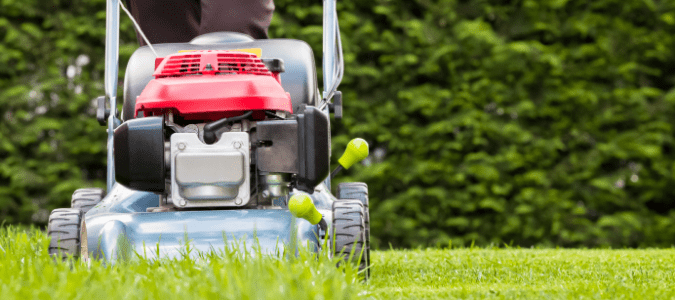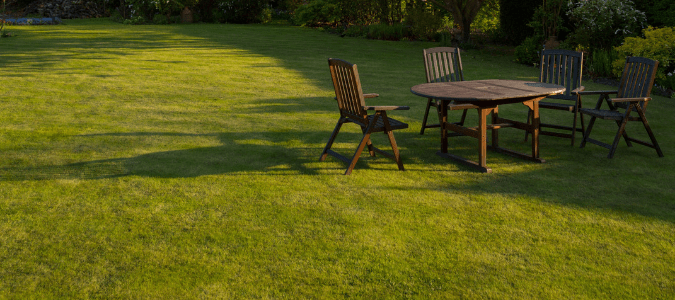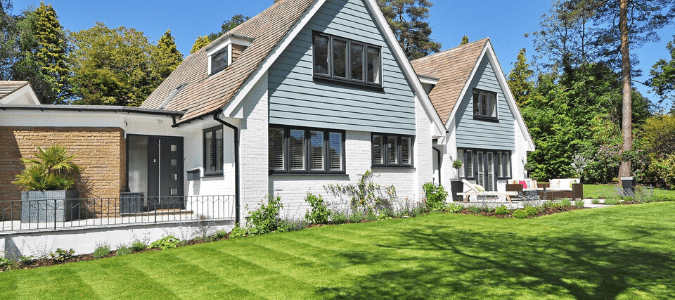Bermuda grass is a popular choice for Texas lawns, and there are several reasons why. First, bermuda grass is a warm season grass that does well in both heat and drought conditions. It’s also hardy, meaning it can take a lot of foot traffic without wearing down. Bermuda grass can grow quickly and thrive from either seed or sod, and it grows well in shallow or deep soil, which makes it versatile.
That said, there is still general maintenance homeowners can do to ensure bermuda grass grows healthy and strong. Follow this bermuda grass calendar in Texas if you want your lawn to look great, even in our extreme temperatures and sometimes under dry and humid conditions.
Mowing
As your grass starts to come out of its dormant phase in March, you can start mowing. Mow the lawn at a 1 to 2-inch height weekly, or as frequently as needed as long as you’re taking care not to scalp the grass. Never heard the term “scalping”? This occurs when more than a third of the grass is cut off the top. Scalping can make your grass less stress-tolerant.
You can maintain this mowing schedule for the rest of the growing season until the grass starts to become dormant again. You may choose to halt your mowing altogether in November, or just mow as necessary to keep your lawn looking tidy.
Watering
Bermuda grass is one of the most heat and drought-tolerant grasses you can have in Texas. For many months out of the year, you can rely on rainfall to keep your lawn hydrated. Typically, you don’t have to start watering your lawn until around May. At a minimum, only water your lawn as necessary to prevent drought stress.
You can use visual cues to see if your grass needs watering. If you see that your grass is starting to wilt or is turning a blue-gray color, this usually indicates your lawn could use some water. After the first few weeks of using visual cues to see how frequently your grass needs water, you can set up your sprinkler system to water your grass once or twice a week, depending on how often you notice your grass needs a boost. Starting in November, you can typically turn off your sprinkler systems for the remainder of the year since your lawn is dormant.
Fertilizing
You can apply fertilizer for the first time once your lawn has started actively growing and you’ve mowed your lawn two to three times. This is typically sometime between mid-April and May. It’s recommended that you test your soil before fertilizing for the best results. That said, the general rule of thumb is to apply a half-pound to a pound of fertilizer for every 1,000 square feet. Fertilizer applications should be spread out every four to eight weeks, and should be done using a combination of quick and slow-release nitrogen. Depending on these factors, you will likely fertilize your grass one to four times during the summer months. You can stop fertilizing for the year in October.
Controlling Weeds
Having a dense lawn is the best way to prevent weeds from growing. There are also other things you can do to reduce your chances of having weeds. Bermuda grass weed control involves applying pre-emergence herbicides and post-emergence herbicides. You’ll want to apply pre-emergent for crabgrass, goosegrass and other summer annual weeds in February or early March. Mid-March is when these varieties typically germinate, so you need to stay ahead of their growing schedule in order for the pre-emergent to be effective.
In May, or before the onset of summer drought stress, apply post-emergent for summer annual weeds and summer perennial weeds. Then, in September, apply pre-emergent for winter weeds like bluegrass, chickweed and henbit. In November, apply post-emergent for winter annuals and cool-season perennials.
Controlling Insects and Disease
In April, keep an eye out for any sign of take-all root rot and spring dead spot. Take-all root rot can look like light green or yellow irregularly-shaped patches of discoloration, thinning grass or bare spots. Spring dead spot usually looks like circular patches of grass that stay dormant during that growing season and expand each year. Also, look out for signs of fire ant mounds. If you’re noticing signs of grubs, such as yellow spots in your grass, you can apply preventative grub products starting in June. As the summer heat starts to cool down, look out for large patch, which is another lawn disease that can often appear as circular patches of discolored or dead grass. To control these conditions, apply fungicides where necessary.
Aerating
You can aerate your lawn anytime starting in April and ending in October. Aeration works best when there is moisture in the soil and is especially beneficial for newly established grasses.
Although bermuda grass is relatively low maintenance, there is still maintenance involved, and many homeowners don’t have the time or desire to do it. If you don’t want to keep track of a lawn care schedule, lawn care specialists can do it for you. They have the tools and training to keep your grass healthy. In addition, they can help you decide on whether St. Augustine grass, bermuda grass or some other type of grass will be the best option for your yard.
You may be wondering about the right bermuda grass calendar because your bermuda grass isn’t looking its best this year. Or, maybe you want to switch out your current grass with bermuda grass. Either way, if you’re looking to plant fresh bermuda grass, it’s helpful to know the best time to plant your new grass.
When To Plant Bermuda Grass
In Texas, when to plant bermuda grass depends on the temperature of the soil. Bermuda grass should be planted when soil temperatures are consistently warmer; this happens when both daytime and nighttime temperatures are between 70 and 95 degrees. In most parts of Texas, this happens early in the year, often before spring actually arrives according to the calendar. You can plant bermuda grass starting in late February or March to grow a thriving lawn.
Bermuda grass grows quickly and well from seeds, sod, plugs or sprigs. This is one of the qualities of this type of grass that makes it so versatile. Of course, there are pros and cons associated with each method. Which one you choose just depends on your particular yard and needs.
Planting From Seed
Growing bermuda grass from seed is the least expensive way to grow this type of grass. Since bermuda grass is a warm season grass, it’s best to set out these grass seeds in late spring or early summer, to make sure they will germinate best and get well established before the dormant season begins in late fall. The rule of thumb for bermuda grass seed is one-half pound to one pound of seeds per 1,000 square feet of lawn. Some types of bermuda grasses aren’t available in seed form; these are called improved varieties of bermuda grass. They can be planted in plugs, sprigs or sod form.
Planting From Plugs or Sprigs
If you’re going to plant bermuda grass plugs or sprigs, you should plan for five to ten bushels of sprigs to cover each 1,000 square feet of yard space. You can plant them six inches apart in rows that are a foot apart from each other. Like other forms of bermuda grass, plugs and sprigs are best grown during their natural growing season, during the warmer months of the year. Whether you grow bermuda grass from seeds, plugs or sprigs, they will need plenty of water and correct fertilizing to grow well and become established.
Laying Sod
Some people prefer to lay out bermuda grass sod even though it’s more expensive, because it’s a little more foolproof. Sod is already established, as opposed to seeds, plugs or sprigs. Therefore, when you plant it, it doesn’t need quite as much special attention to thrive. You also won’t need to cover the entire area that you’re sodding. Instead, you can lay out the sod in a staggered or checkerboard pattern, and it should quickly grow into the empty spaces.
Another good thing about planting bermuda grass sod is that it can be planted anytime throughout the year, especially if you just need to patch a small part of your lawn. Of course, bermuda grass sod will grow best and become most easily established during its natural growing season, from late spring through summer and into early fall.
A lawn care professional is a great resource whether you have a patchy lawn that needs a little help to look and grow better, or you need a whole new lawn installed. A professional can save you both labor and trouble by determining the best way to install a green, thriving bermuda grass lawn. A lawn care specialist can also set up a lawn maintenance schedule to keep your yard healthy and beautiful throughout the year.
Of course, another consideration when deciding how you want to plant your bermuda grass is how long it takes for this type of grass to grow.
How Long Does It Take for Bermuda Grass To Grow?
Many people considering Bermuda grass wonder: “How long does it take for bermuda grass to grow?” Bermuda grass is a quick-growing grass; this is one of the reasons many landscapers and homeowners choose it. This is true whether you grow your lawn from seed or lay down sod. But, growing bermuda grass from seed, plugs or sprigs takes somewhat longer than laying out sod.
Under ideal conditions, bermuda grass seed can germinate within three to seven days and you can have a limited, but basic coverage within five to six weeks. If planted in conditions that aren’t ideal, it can take three weeks or longer for the seeds to germinate. This is why it’s helpful to plant your bermuda grass during its peak growing season.
Since sod is rectangles of grass already established in a layer of soil, sod is the quickest and easiest way to get bermuda grass established.
Growing a healthy lawn is certainly doable on your own, especially if you have time and you enjoy learning about what nutrients and other maintenance your lawn will need. Many people find this aspect of lawn care to be a chore. Lawn care specialists are professionals who are trained to know what each type of yard and soil needs to support a healthy lawn. They can take care of every step for you, from designing your yard and choosing the right type of grass to planting it and caring for it throughout the year. That leaves you free to enjoy the benefits of your healthy yard with none of the headache.
ABC Can Keep Your Bermuda Grass Healthy and Strong
While bermuda grass is relatively low maintenance, there are still lots of tasks involved in keeping it green and healthy. Instead of laboring over your lawn, let ABC Home & Commercial Services keep your grass looking its best. Our professionals can handle every aspect of your lawn care schedule, so you can reap the benefits.



